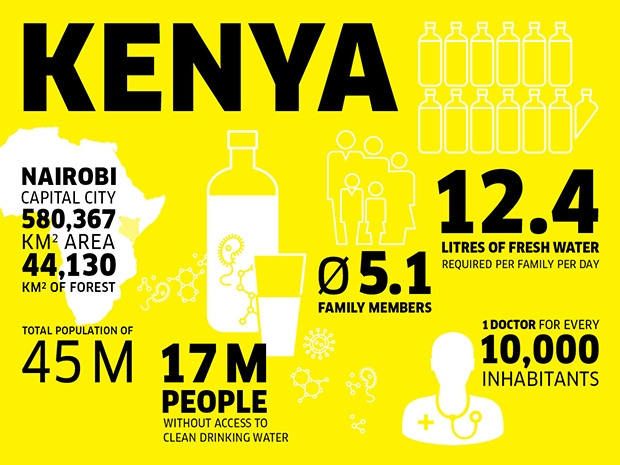Sarah's Quest for Clean Water
To make polluted water drinkable, it is boiled by many people in Kenya - a lot of firewood is needed. The demand sometimes leads to a growing logging rate, which contributes to an increase in CO 2 emissions. A climate protection project in Kenya tries to counter this: for the project, water filters are distributed to households. They are not only intended for human health, but also contribute to climate protection.

Sarah has to go to the woods four or five times a week to get new firewood for her family. The way she has to go is long. Branches and branches lie heavily on the head and shoulders of the girl - always alternating, so that the weight remains tolerable on the long stretch. You could also buy the wood, but that's way too expensive.
The 15-year-old lives with her family in a small village in western Kenya. Many people in this secluded area live below the poverty level - in mud huts, without medical care and without drinking water. The next river is dirty and contains many bacteria - but still: the inhabitants drink the murky wet, because there is no alternative. The consequences are often serious illnesses such as typhus and cholera. On the advice of the doctors the inhabitants cook the water over an open flame. For many, this is the only way to kill the bacteria that are responsible for the diseases.
The need for firewood is one of the reasons why forest rotting in Kenya has grown sharply in recent decades. Wood is by far the most important source of energy and is used for cooking and heating - 90% of wood is used as firewood. As a result, the forests lose their function as storage and converter of CO 2 and the air pollution increases
Clean drinking water for Sarahs village
Vestergaard Frandsen wants to change this: The company for disease control technologies operates a climate protection project, which has so far distributed 900,000 water filters to Kenyan households. The LifeStraw® Carbon For Water program is designed to help people filter their water rather than boil it down. The project is financed by the sale of carbon credits. No electricity or fuel is required for water filtration. The central element is a plastic housing about 30 cm long, in which filter membranes are located. They ensure that viruses as well as bacteria are removed from polluted rivers, lakes, rainwater or puddles.


Sarah's family also got a water filter. The so-called LifeStraw® is fastened with a rope to the ceiling of its hut. The dirty water is simply filled into the processing unit with a filter and can be drained again via a tap. With the help of the new method, the water can be potted without boiling. Already 3.6 million people in Westkenia have such water treatment units with filters and use them regularly. At first, the parents were still skeptical, says Sarah, but now the advantages are overwhelming: your health has improved significantly, no firewood has to be taken for clean drinking water, time is saved. The sustainable program also provides that the water filters can be repaired or replaced free of charge in any service center in the province. Vestergaard Frandsen therefore places people on the ground to help ensure water quality.
In addition to the health and economic benefits for the people, the filter system also benefits the environment. Because less firewood is needed, fewer trees are felled. In this way, more CO 2 can be stored and less greenhouse gases are released into the atmosphere. Since the start of the project in 2011, 4 476 205 tonnes of CO 2 have already been saved.
Climate change and climate protection projects
The increase in greenhouse gas emissions, such as rising CO 2 concentrations in the atmosphere, leads to a change in our climate. The impact is already visible all over the world: melting polar caps, the rise in sea level and the increase of weather extremes are only a few examples.
In order to stop the rise in global warming, numerous measures have been taken to reduce greenhouse gas emissions since the signing of the Kyoto Protocol. This includes, for example, compensation for CO 2 with the help of climate protection projects. The savings achieved in this way can be traded in the form of emission reduction certificates. Each certificate stands for a certain quantity of CO 2 , which is saved by the project. To be able to generate these, climate protection projects must fulfill certain criteria, for example, to achieve a long-term saving of greenhouse gas emissions.
The Vestergaard Frandsen project receives these certificates for the reduction of greenhouse gases. Companies, but also individuals, can buy them and support the climate protection project. Thus, CO 2 emissions, for example caused by car use, electricity consumption or air travel, are compensated for.
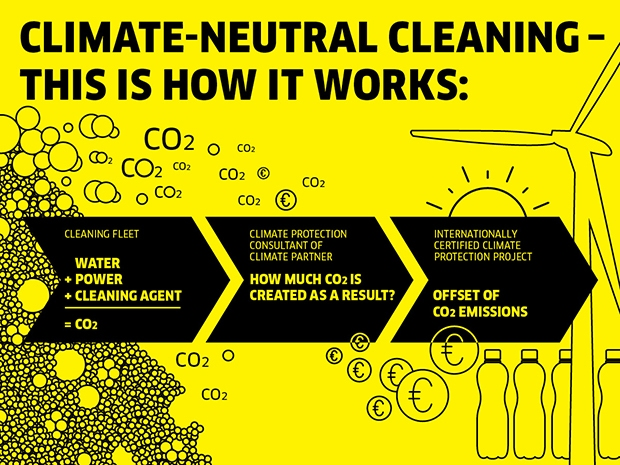
Climate cleaning
Kärcher is committed to sustainability and climate protection and supports certified climate protection projects such as water treatment in Westkenia. Even with the use of cleaning devices such as scrubber suction machines, CO 2 emissions are generated, for example, by electricity consumption, which can not be completely avoided.
In cooperation with climate protection consultants ClimatePartner 2 , Kärcher therefore offers users of its scrubbing machines the ability to compensate for the CO 2 emissions that are generated during their use. To this end, the annual CO 2 emissions of the fleet are determined by their size, models and average use. Each tonne of CO 2 is used to invest a fixed amount of money into an internationally certified climate protection project in order to save greenhouse gas emissions.
Together with ClimatePartner, Kärcher supports the climate protection project of Vestergaard Frandsen and thus enables an improvement in the water supply in Westkenia. International standards such as the "Gold Standard" - one of the most stringent standards developed by 40 non-governmental organizations - ensure project quality.
Since it is irrelevant to the climate at which place CO 2 is saved in the world, every avoided CO 2 tonne relieves the global climate to the same extent. Likewise, it is not relevant whether greenhouse gases are saved in developing countries or in Central Europe. The basic idea of the compensation is to prevent the emission of a certain quantity of CO 2 , which is not avoided at one place in the world, at a different location. The water filters in Sarah's village help to protect the climate.
Sarah is also personally profiting from her family's LifeStraw®: because less firewood is needed, she does not have to carry the heavy branches home and take the long road, so more time for school and learning.

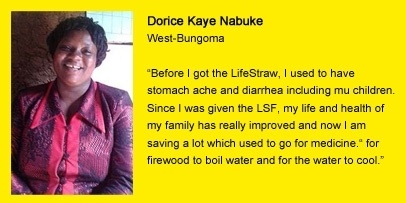
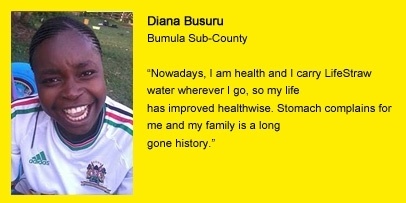
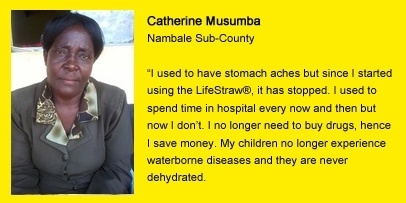
1 The Kyoto Protocol is an additional Protocol, adopted in 1997, for the purpose of climate protection in the United Nations Framework Convention on Climate Change (UNFCCC). The agreement, which entered into force on 16 February 2005, establishes binding targets for the emission of greenhouse gases, which are the main cause of global warming.
2 ClimatePartner ClimatePartner is one of the leading climate protection consultants in the German-speaking area, based in Munich. Since its founding in 2006, ClimatePartner has pursued the goal of integrating climate protection into as many areas of our daily lives as possible. The company assumes for Kärcher the selection and provision of high-quality climate protection projects that are used for CO2 compensation and provides the corresponding TÜV-certified IT infrastructure for the handling of CO2 compensation.

